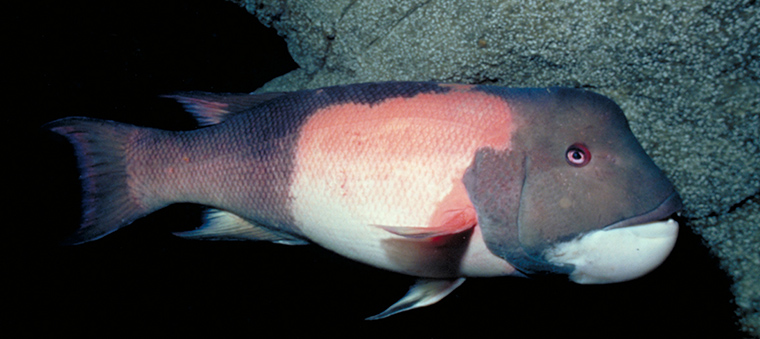When walking through the underwater tunnels at Aquarium of the Bay, one fish in particular tends to stand out from the others.

There is more to the California sheephead than its distinctive shape. The unique species are all born as females, but eventually most transform into males. Photo courtesy of Aquarium of the Bay
By Mallory Johnson
Published: February, 2017
When walking through the underwater tunnels at Aquarium of the Bay, one fish in particular tends to stand out from the others. With its distinctive shape, color and size, most people can’t help but to notice the California sheephead.
What most people don’t realize about this fish is that its appearance isn’t the only thing that makes it unique; it has quite an interesting lifestyle as well.
Part of the wrasse family, the California sheephead is a protogynous hermaphrodite. Simply put, they are all born as females, but eventually transform into males. This transition takes place thanks to hormonal changes triggered by environmental and social cues that take this fish from a reproductively-functional female to a fully-functional male.
The transitional phase from female to male can take anywhere from two weeks to several months to complete, and typically takes place in the winter months between spawning seasons. Generally, they will make their transition between five and eight years, but for some slower growing fish, they may never change sex at all. It’s also possible that aggressive interactions with overly dominant males can suppress sex change in some females, and they won’t change unless the alpha male is removed from the environment.
The California sheephead has three distinct appearances, each of which correlates to its current sexual state. Even a casual onlooker can identify what stage a sheephead is in thanks to these distinguishable looks.
-
Juveniles: As juveniles, they are typically gold or salmon-colored with black spots on their fins and a silver stripe that runs the length of their body.
-
Mature Females: As they grow older into mature females, the spots and stripe fade, leaving them with an overall pink coloration.
-
Males: The sheephead makes one last change during its final transformation from female to male. The head and tail turn black, leaving a bold pink midsection in between. Males also develop a new hump atop their heads, giving them a new, unique silhouette.
Another characteristic that helps this fascinating fish stand out is its protruding canine teeth. These teeth come in handy too, as they tend to dine on hard-shelled prey like sea urchins, mollusks, lobsters, and crabs.
The California sheephead typically lives on rocky bottoms, particularly in kelp beds that offer protection from predators. They aren’t very adventurous, as they prefer to stick around the same reef. This fish is diurnal, meaning it hunts during the day and seeks shelter at night in crevices and caves.
You can learn more about the California sheephead and see them in person in the Under the Bay exhibit at Aquarium of the Bay. For more information, visit www.aquariumofthebay.org.
Mallory Johnson is the Communications Manager at Aquarium of the Bay, a nonprofit dedicated to protecting, restoring and inspiring the conservation of San Francisco Bay and its watershed.

